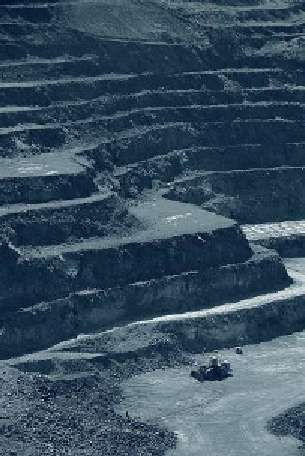Environmental Engineering Reference
In-Depth Information
FIGURE A1.2.2
The Ranger Uranium Mine, near Jabiru, East of Darwin,
Australia
Photo credit: Stephen Codrington
France since 1910. The ore deposit is approaching exhaustion, and planning and prepa-
ration for this eventuality has been underway for years. The major environmental issue
revolves around the waste piles dumped adjacent to the benei ciation plants prior to 1934.
These were placed without liners or other containment features. Subsequent dissolution
of the salt by rain has contaminated the underlying aquifer giving rise to plumes of salt
contamination. The affected groundwater system of the upper Rhine valley is one of the
largest sources of drinking water in Europe.
Mt ISA
The Mt Isa Mines produce copper and silver/lead/zinc from separate ore bodies. Located
within a metals rich province in Northern Queensland, these major underground mines
have been producing since 1931. Built in 1978 with a stack height of 270 m, the Mount Isa
lead smelter in Inland Queensland, Australia operates the tallest l ue gas stack of any pyro-
metallurgical operation on Earth. Up to Year 2000, the smelter was operating without a
desulphurization unit dispersing signii cant amounts of SO
2
through the stack. Depending on
the prevailing wind direction it was possible to detect the plume in Perth some 2,000 km away.
Mt LYELL
The Mt Lyell Mine, located in western Tasmania has been producing copper since 1896, and
has played a major role in development of this rugged, mountainous region. The barren
landscape in the vicinity of the mine, due to timer cutting and the effects of sulphur diox-
ide emissions during the older mining periods, contrasts markedly with the lush vegetation
of surrounding areas. For many decades, tailings were discharged to the Queen River, and
thence via the King River to Macquarie Harbour where they deposited to form a delta.
Acid mine drainage from underground workings has also contributed to contamination











Search WWH ::

Custom Search